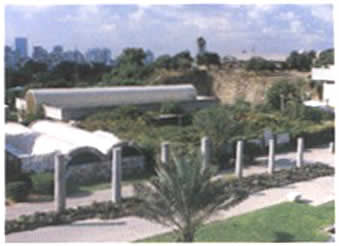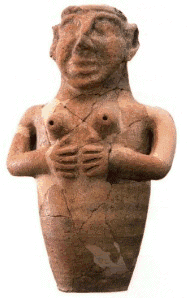Search our Archives:
» Home
» History
» Holidays
» Humor
» Places
» Thought
» Opinion & Society
» Writings
» Customs
» Misc.
|
Tel Qasile
By Jacqueline Schaalje
This year Tel Aviv is celebrating its 90th birthday. It would seem that there would not be any connection between this young city and archaeology, the subject of this story. Naturally, one would say, there does not exist any archaeology in this young city. What, the archaeology of Zionism? Sounds strange!
 |
Tel Qusile, an archaeology site in Tel Aviv
|
One may be pretty surprised that there is indeed an antique site in the city, albeit just outside the Northern border of the city, on the shore of the Yarkon river. Strictly speaking this area belongs to Ramat Aviv. On the premises of the Eretz Israel Museum at the campus of Tel Aviv University the remains of a Philistine city are found.
This city, Tel Qasile, formed a flowering harbour settlement through the 12th- 10th Centuries BCE. Its location on the river shore guaranteed foreign trade over the Mediterranean, and also enough water to provide irrigation for agricultural projects. In its flowering period in the 10th Century BCE there lived the incredible amount - for that time - of up to 800 inhabitants. The remains of the town look a bit smaller now than Tel Qasile used to be in antiquity. In the Museum one can walk round and see only 2/3 of the original size of the town. The rest has disappeared because of erosion and human activities.
Until far into this century Tel Qasile used to be the only well-dug Philistine site, before Ekron was excavated extensively in more recent years. In Tel Qasile are found the most extensive pottery finds from the whole of Israel. The earthen ware was fabricated in a small pottery workshop which continued to function during the whole of the Philistine occupation of the site. The pottery shows influences not only from local traditions but also from countries abroad, like Egypt, Cyprus and the Aegean area.
The foreign influence can be explained because of two reasons. The first one is the origin of the people who settled in Tel Qasile and built the first town here. They belonged to the somewhat mysterious Sea Peoples. It is not absolutely certain where the Sea Peoples come from, probably from the Aegean, and they also seem to have sojourned a while on Cyprus. Around the 12th Century they started invading the Land of Israel. They seem to have preferred to settle in Egypt first, because they are known from Egyptian contemporary sources. But they were kicked out of Egypt after they lost a battle against Ramses III around 1190 BCE. On Egyptian reliefs, the Sea Peoples are portrayed as a fierce tribe of warriors arriving in ships, and wearing characteristic head-dresses with feathers. Their women and children were transported in carts pulled by oxen.
The Sea Peoples who settled in Israel only later came to be called Philistines. This was probably around the 10th Century BCE. It is interesting that the Israelites also settled in Israel (then still called Canaan) in the same period as the Sea Peoples (12th-11th Century) BCE. In the Bible the Philistines are mentioned precisely from the time that they seem to have started to form a bother to the Israelites, because they were both trying to expand their territory. This was in the 10th Century BCE, in the time of the Philistine wars of Saul and David. Palestine was the Greek name for the Land of Israel, the land was mistakenly so named by Greek traders who only visited the coast which was settled by the Philistines.
Tel Qasile belonged to the five cities of the Philistinian Pentapolis, which further consisted of Ashkelon, Ashdod, Gaza and Ekron. These consisted of very powerful city-states with a culture which was far advanced upon the Israelites, who mostly concentrated in small villages in the hill countries of Ephraim and Manasseh. That the Philistines were more advanced is also clear from the story in the Bible which states that the Philistines had a monopoly on iron (I Sam. 13:19-20). In order to get weapons the Israelites traded their agricultural equipment with the Philistines. In Tel Qasile some iron objects were found, tools with a wooden grip for instance. Other iron objects found in Israel from the 10th Century BCE are generally associated with Philistine sites. It is still not known how this Philistine monopoly on iron could come into existence. A recent theory says that the Philistines brought the technique of iron melting, which requires higher temperatures than for the melting of copper, from the Aegean cultures.
Many cult objects and artefacts, some very beautifully decorated, were also excavated in Tel Qasile. Most were found in the Temple area. They consisted of typical Philistine ware, and also artefacts from Aegean or Egyptian origin like scarabs. There were faience beads, ivory objects, small pottery vessels in the form of birds and an anthropomorphic jug designed as fertility goddess with breasts functioning as spouts.
The temple area was excavated in 1971/72. The sanctuary was already built in the first city in the 12th Century BCE, and rebuilt two times, before the city was for unknown reasons destroyed in the 10th Century.
To which deity the temple was dedicated is not known. There is not only precious little information about the Philistines in general, but also about what their cult was like we only possess a few references. The Bible mentions priests and diviners among the Philistines (I Sam. 6:2). In Gaza and Ashdod the god Dagon, of Phoenician stock, was worshiped (Judges 16:23, I Sam 5:2). The local deity in Ekron was Ba'al Zebub. In Tel Qasile a pottery ostraca was found with "Beth Horon" written on it. A possible conclusion is that the god in Tel Qasile was Horon, a Canaanite god. It is probable that the Philistines upon coming to the Land of Israel took over the worship of local, in this case Canaanite, gods.
The first two temples consisted of one room, but the third temple was extended to three rooms. The third temple also had a shrine. On the site in the Museum one may see the area of the temple but it takes a practised eye to identify the exact building, as other structures are lying around it. The different layers of the temples are all dug up which makes for extra confusion.
Although there were similar temples in Israel and neighbouring countries, for instance the one-room temple in Hazor, it seems that the one in Tel Qasile is somewhat unique. There is only one description known of a Philistine temple. This is the temple of Gaza as described in the story about Samson in Judges 16:23-31. This temple was destroyed by the Israelite hero, who in his wrath at the Philistines pulled down the pillars of the temple with his bare hands, at which the roof came down. The temple in Tel Qasile also had pillars in the central room in the third phase of its construction.
Harder to verify is the size of a typical Philistine temple. The one in the Samson story could hold 3000 men and women on its roof. As the measurements of the Tel Qasile temple were only 6 x 7 square meters, to hold this amount of people seems not possible. Also other temples of the same period are not large; this was because a temple was meant to function as the abode of the deity.
The Tel Qasile site continued to be populated until the destruction of the town in the 10th Century BCE. At the end of the 9th Century BCE it was again destroyed; again for unknown reasons. After this destruction the city stayed deserted during the 9th, 8th and 7th Centuries BCE. There was a short reoccupation during the 7th Century BCE. This may be related to the expansion of Israelite territory under King Josiah, as the pottery finds of this period look like Israelite ware. What happened after this is not known, but the Philistines as a people disappeared when they were conquered by the Babylonians in the 6th Century BCE, just like the Judahites. But in contrast with them, who returned from Babylonia back to Judah, it is not known where the Philistines ended up.
 |
Philistine vessel of fertility goddess with breasts as spouts, found in
Tell Qasile
|
~~~~~~~
from the July 1999 Edition of the Jewish Magazine
|
|
Please let us know if you see something unsavory on the Google Ads and we will have them removed. Email us with the offensive URL (www.something.com)
|





|
